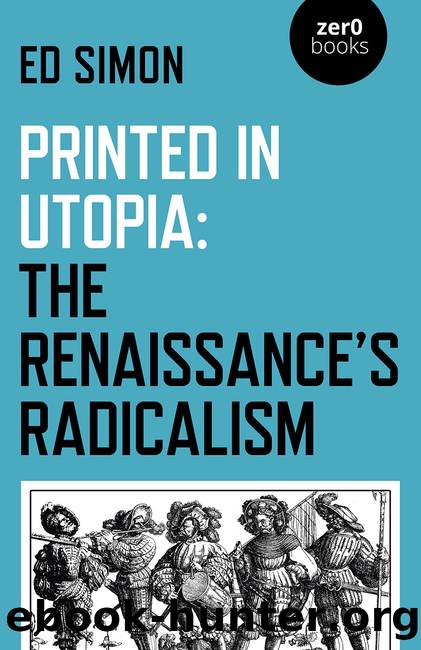Printed in Utopia by Ed Simon

Author:Ed Simon
Language: eng
Format: epub
Publisher: John Hunt Publishing
Published: 2020-06-05T00:00:00+00:00
The Dark Lady Inscribed in the Book of Life
In 1597 Amelia Lanyer visited the astrologer and physician Simon Forman several times at his practice on Philpot Lane in Westminster. Across thousands of pages, Forman, for whom the appellation “physician” is significantly less rigorous than it would be today, recorded his interactions with the residents of London. Forman has long been of interest because of the records of his attendance at plays from the Globe to the Blackfriars, his prodigious sexual conquests (for which he invented the odd noun “halek,” as in “I had halek today”), and his testimonies about life outside of the noble coterie. Forman is also interesting because of Lanyer, who some critics have claimed inspired the infamous “Dark Lady” of William Shakespeare’s sonnets. The evidence, as with many things from what is the undiscovered country that is the past, is incomplete and sometimes difficult to read (often literally, as with Forman’s awful penmanship which has caused critical problems in past scholarship). But what is apparent is that Lanyer wasn’t Forman’s regular sort of client. While she may or may not have been Shakespeare’s Dark Lady, she was most definitely the first professional woman poet in the English language. She is the author of an epic, feminist, mystical rewriting of Genesis entitled Salve Deus Rex Judaeorum, published in 1611, and which has only recently been given critical attention.
And just as fascinating, she is perhaps the first “Jewish” poet in English as well.
She was the daughter of a court musician and the wife of another, former mistress to Henry Carey, the Baron Hunsdon (who was first cousin to the queen) and some years after her associations with the magician Forman, her literary patron would be Margaret Clifford, Countess of Cumberland. It was to the last that she dedicated her Salve Deus Rex Judaeorum, attaching several patronage poems to her single volume, taking part in the complex economics of negotiation and validation existing between a poet and her patron. Among these poems was her admittedly treyf-sounding A Description of Cooke-Ham (the name is that of the estate it describes), written in the Augustan conventions of the “country house poem,” celebrating the space of Clifford’s residence which Lanyer made her home when widowed. Never an aristocrat herself, Lanyer was of the middling yet rising gentry. Her mother, Margaret Johnson, was aunt to Robert Johnson who wrote many of the musical settings for Shakespeare’s plays, her husband Alfonso was a second-generation Huguenot who performed for Elizabeth, and her father Baptista Bassano played for Henry VIII.
It is from Baptista’s side that Lanyer has her Jewish associations, for some scholars with varying degrees of certainty have claimed that the Bassano line were marranos, converted Jews maintaining connections with their ancestry. Some argue that the family were originally Moroccan Jews, a Sephardic complexion used to claim Lanyer as the Dark Lady. Susanne Woods, Lanyer’s most complete biographer and one of the scholars who has done more than anyone to kindle an appreciation of her poetry, finds the evidence compelling but inconclusive.
Download
This site does not store any files on its server. We only index and link to content provided by other sites. Please contact the content providers to delete copyright contents if any and email us, we'll remove relevant links or contents immediately.
4 3 2 1: A Novel by Paul Auster(11739)
The handmaid's tale by Margaret Atwood(7406)
Giovanni's Room by James Baldwin(6743)
Asking the Right Questions: A Guide to Critical Thinking by M. Neil Browne & Stuart M. Keeley(5317)
Big Magic: Creative Living Beyond Fear by Elizabeth Gilbert(5299)
Ego Is the Enemy by Ryan Holiday(4885)
On Writing A Memoir of the Craft by Stephen King(4635)
The Body: A Guide for Occupants by Bill Bryson(4534)
Ken Follett - World without end by Ken Follett(4409)
Bluets by Maggie Nelson(4224)
Adulting by Kelly Williams Brown(4197)
Eat That Frog! by Brian Tracy(4100)
Guilty Pleasures by Laurell K Hamilton(4085)
White Noise - A Novel by Don DeLillo(3805)
The Poetry of Pablo Neruda by Pablo Neruda(3779)
Fingerprints of the Gods by Graham Hancock(3706)
Alive: The Story of the Andes Survivors by Piers Paul Read(3703)
The Book of Joy by Dalai Lama(3648)
The Bookshop by Penelope Fitzgerald(3593)
